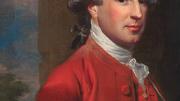Theodore E. Stebbins Jr., curator of American art emeritus at the Harvard Art Museums, sums up the University’s expansive holdings of early American paintings as “very big,” “very good,” and—scattered in a hundred buildings across campus—“hard to see.” His new book, written with former senior curatorial research associate Melissa Renn, brings together this relatively unknown, historically important collection in American Paintings at Harvard, Volume One: Paintings, Watercolors, and Pastels by Artists Born before 1826 (Yale University Press). (Volume Two, covering artists born between 1826 and 1856, was written first, and released in 2008.)
In a Wednesday evening lecture celebrating the book’s release, Stebbins called the group of 493 works “the strongest part of our collection,” but one that still “remains largely unknown.” The new volume includes some of the earliest extant American paintings, because, as Stebbins explained, Harvard owns about a half dozen of the 40-odd paintings that survive from the seventeenth century. In fact, he said, Harvard helped found and fund the tradition of portraiture in the English colonies, as the young college consciously modeled itself on Cambridge University, which had a rich tradition of portraits of scholars and graduates. (In the New World, big donors earned the same honored treatment.) Harvard’s focus on the “significance of the sitter” over the artistic merits of the work has contributed to what Stebbins, in the title of his lecture, called the University’s “amazing and somewhat accidental collection of American Colonial and Federal paintings.” These include works by some of the periods’ most famous artists, including more than a dozen Gilbert Stuarts, as well as 25 works by John Singleton Copley, whose portrait of fellow artist Benjamin West adorns the book’s cover.
Each entry in the volume contains a scholarly essay and as full a provenance, exhibition history, and listing of scholarly mentions as the authors were able to construct. (Many of the works were previously unpublished.) The process of putting together the entries allowed Stebbins, Renn, and their team of fellow scholars to settle longstanding controversies about several works in the collection. A deep dive into the provenance of a Charles Willson Peale portrait of a previously unknown Maryland woman identified her as Susanna Steuart Tilghman, while new x-ray analysis of a Benjamin Franklin portrait often attributed to Robert Feke revealed that the unusual-looking face was in fact a later edit by a different painter. (Many of the works can be viewed online, using the museums’ revamped collection search.)
Just as the newly reopened physical space of the Harvard Art Museums seeks to highlight connections across the University’s art holdings, the new book does the significant job of bringing together this often-scattered collection for the first time. The volume includes more than 100 works from the Peabody Museum of Archaeology and Ethnology, for example. It also highlights works that are displayed in the museums for the first time, including two paintings now in galleries on the second floor: the Gilbert Stuart portrait of George Washington—once among the most cloistered of campus artworks (it presided over meetings of the Harvard Corporation)—and a portrait of John Quincy Adams that had to be “wrestled away” from the Adams House dining hall, Stebbins said. “Any other place in America, this wouldn’t be hanging in a dining room,” he observed. “This would be one of the centerpieces of the museum collection.” Indeed, given the constraints of space and the politics of regaining paintings from other parts of the University, this hefty new book, which weighs in at nine pounds, will remain one of the best places to explore Harvard’s large collection of early American works, despite the expanded museums’ reopening. As he presented the first public lecture in the building’s new Menschel Hall, Stebbins reflected, “No one will ever see the whole collection unless another building of roughly the same size as this one happens to be built.”









